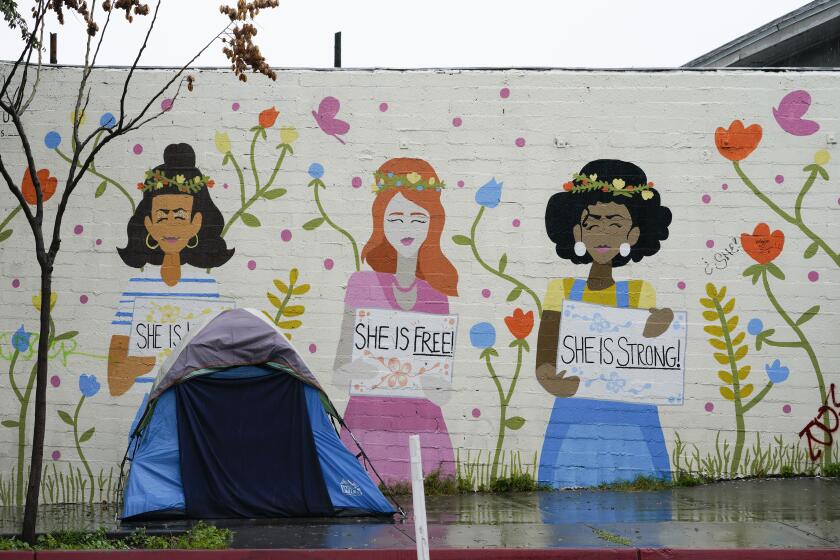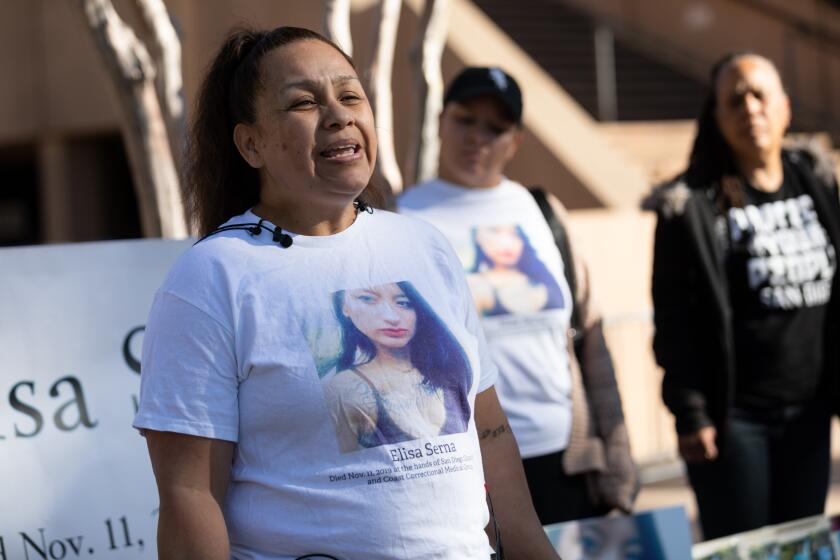Heat takes toll on prison inmates
There’s no easy in hard time.
Prison is supposed to be unpleasant and uncomfortable, a deterrent for people who veer from the straight and narrow. But when temperatures rise across San Diego County, as they have at record highs this year, the heat climbs even higher inside the concrete cells at the Richard J. Donovan Correctional Facility.
“It’s pretty bad,” said Nathaniel Regalado, who has about 20 months remaining on a 13-year sentence for armed robbery. “Every morning I have to wash my sheets. I’m just covered in sweat, every part of my body.”
Regalado, 33, is one of eight inmates and employees to report in telephone interviews with U-T Watchdog what they called extreme heat conditions inside cell blocks and other facilities at the Otay Mesa prison. Most were reluctant to be quoted by name for fear of retaliation from guards or supervisors.
They described an atmosphere rife with tension and medical emergencies due to poor ventilation and a lack of air conditioning. One prison employee said temperatures inside the cells can run up to 20 degrees higher than the climate outdoors, and guards are slow to provide basic relief, like handing out ice or swinging open the heavy metal doors.
Otay Mesa had five days of 90-degree-plus heat last month, peaking on Sept. 9 at 99 degrees.
State prison officials say they do their best to make inmates and staff as comfortable as possible during heat waves.
“Inmates are encouraged to refrain from strenuous activity,” said Bill Sessa, a California Department of Corrections and Rehabilitation spokesman. “They are given extra fluids, ice and are encouraged to take more and longer showers to cool off and prevent heat stress.”
Sessa pointed to a protocol that calls for monitoring prisoners for health effects from high heat and measuring temperatures inside cells every hour when temperatures exceed 90 degrees.
“In addition, we maintain a list of inmates who may be especially vulnerable to heat stress, either because of their physical condition or their medications,” Sessa said. “If necessary, those inmates can be moved to medical or mental health wards, which are air-conditioned, until it is safe to take them back to their regular housing unit.”
Inmates say readings taken inside their cells are misleading because the samples are performed with guards holding thermometers barely an inch inside the door. They also say guards are lax about handing out ice and fluids as needed.
Some of the prisoners wrap dampened washcloths around their necks at night. Others pour water onto the floor and lay in the puddles to escape the heat.
Many of the inmates have digital clocks in their cells purchased at the prison by family or friends. In addition to the time, the devices display the temperature, which routinely reads 88, 90 or 92 degrees late into the night, they say.
“It’s 94 degrees inside my cell at 12 o’clock at night and there is no ventilation going in or out of these cells,” said William Nible, 57, who was handed a life sentence on his third strike when he was arrested a few years ago for resisting arrest. “You don’t sleep at night. You’re irritable. There’s always the potential for violence because of that.”
The housing blocks at Donovan contain up to 100 cells each, with most occupied by two inmates. The buildings feature a horseshoe-like design that includes a shared dayroom lined with tables for prisoners to read, play chess or otherwise pass time.
The dayrooms are cooled by a pair of industrial fans. Inmates say the fans circulate hot air while nearby guards monitor the prisoners from air-conditioned offices. Sessa said employees work under the same conditions as inmates.
“When it’s hot, it’s hot for everybody — staff and inmates alike,” the prisons spokesman said. “And we all look forward to cooler days.”
Prisoner Anthony Falco was so concerned about his wellbeing, he filed a request for service in August with the plant operations office at Donovan, asking they do something to relieve the place of constant heat.
“I am 81, in a wheelchair, ADA. I have a heart condition,” he wrote, referring to the federal Americans with Disabilities Act. “The temperature in my cell stays between 82 and 92 degrees day and night. This is dangerous for us ADA inmates. Please fix this ASAP.”
The response dated a week later said there was nothing the maintenance staff could do. It suggested Falco submit a different form to the Department of Corrections and Rehabilitation.
“All units working as designed,” the response said. “There is no A/C.”
Concern over conditions inside Donovan prison cells last year prompted lawyers from the American Civil Liberties Union to contact the warden and request information about how prisoners are treated during periods of extreme heat.
“All individuals have the right to be free of cruel and unusual punishment,” ACLU staff attorney Kellen Russoniello wrote in September 2014.
The prison provided the ACLU its operational plan for high temperatures, including the special measures officers take to protect the most vulnerable inmates. Russoniello is not certain the directions are always followed.
“Having a plan for extreme heat is one thing; whether it’s adequate and whether Donovan adheres to it are separate issues,” he said. “Detention conditions, including prolonged exposure to extreme heat, remain an issue of concern for the ACLU that doesn’t pass with the seasons.”
According to inmates, the situation grows worse when the power goes out and overhead fans are unable to circulate even the warm air.
In August, when two planes collided on Otay Mesa and five people were killed, power was out for five-plus hours, and temperatures climbed to nearly 100 degrees inside cells, inmates said. Late last month, service was disrupted for 90 minutes or more.
“There were guys quite angry the other night, banging on their doors, screaming and yelling,” said inmate Darrin Gasper, 53, who said he has about two years remaining on an illegal pornography conviction. “It takes 20 minutes for them to respond. I’ve seen a couple of people on the yard fall down and have to be shipped off by ambulance.”
Under its 12-page heat plan, updated in July 2014 and signed by the chief executive officer and warden, officials are required to submit monthly summary reports to the department’s Statewide Mental Health Program office in Sacramento outlining all heat-related activities and responses.
The Watchdog requested copies of the 2015 reports through September under the California Public records Act and is awaiting a response.






